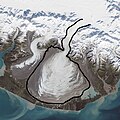Stampa:Malaspina Glacier, Alaska (boundary).jpg
Dehra

Daqs tad-dehra proviżorja: 600 × 600 pixels. Riżoluzzjonijiet oħra: 240 × 240 pixels | 480 × 480 pixels | 768 × 768 pixels | 1,024 × 1,024 pixels | 2,048 × 2,048 pixels | 6,000 × 6,000 pixels
Fajl oriġinali (6,000 × 6,000 pixel, dimensjoni: 11.5 MB, tip ta' MIME: image/jpeg)
Kronoloġija tal-fajl
Agħfas fuq il-grupp data/ħin biex tara l-fajl biex tara kif jidher dak il-ħin.
| Data/Ħin | Minjatura | Qisien | Utent | Kumment | |
|---|---|---|---|---|---|
| kurrenti | 21:44, 27 Frar 2024 |  | 6,000 × 6,000 (11.5 MB) | Nwbeeson | Uploaded own work with UploadWizard |
Użu tal-fajl
Il-Paġna segwenti twassal għal din l-istampa:
L-użu globali tal-fajl
Il-wikis segwenti jużaw dan il-fajl:
- Użu fuq en.wikipedia.org
